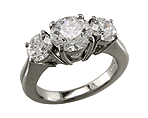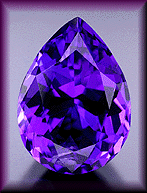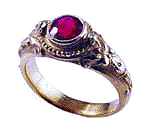
|
|
Issue 4, 2000
If you enjoy our newsletter, please sign up to receive The Bijoux News on a regular basis. Happy reading! |
||
|
Arthur Anderson Editor |
||
|
**********
Alexandrite - The Christmas Stone
By Arthur Anderson
It was the end of a long, cold Russian winter. A thick blanket of snow still covered the ground. Dagger-like icicles hung from the roof lines and trees. And deep within the Ural Mountains, a poor miner labored in a dark, dreary mine. Then suddenly, a glittering crystal caught the miner's eye. As he examined the crystal, he saw its color shift from red to green and then back to red as he turned it over in his hand. This magical gem was appropriately named the "Christmas Stone." The year was 1830. Meanwhile back at the warm and cozy Tsarist palace, the young Tzarevitch, Alexander, was celebrating his twelfth birthday. The discovery of the Christmas Stone on the Tzarevitch's birthday and the coincidence that the imperial colors of the Tsarist Court were also red and green, were seen as very favorable signs. Naturally, the gem was promptly renamed Alexandrite and became a favorite among the Russian nobility. Although parts of this story of alexandrite's discovery are probably fanciful, there is no denying the intoxicating beauty of this rare gemstone. When properly cut, the finest alexandrite crystals exhibit an astounding color change. In sunlight fine alexandrites are a rich bluish-green, while in incandescent or candle light they turn a deep raspberry red. It is little wonder that alexandrites became the gemstone of choice among the rich and titled. Unfortunately, by the early 1900s the original source of alexandrites in the Ural Mountains was exhausted. Although some new material is still being recovered from the tailings of the old mines, today most Russian alexandrites are found beautifully set in antique jewels. The discovery of gem-quality alexandrites in Brazil in the late 1980s sparked renewed interest among gem collectors and jewelry designers. The finer Brazilian alexandrites exhibit a strong color change that rivals the earlier Russian stones. In addition, the Brazilian gems generally have fewer inclusions and exhibit greater clarity. But, unfortunately, like the earlier Russian deposits, the Brazilian sources appear to be limited. With its great beauty and rarity it is little wonder that fine alexandrite can be expensive. In top grades and larger sizes, alexandrites can sell for over $30,000 per carat. Even smaller, fine stones will cost at least several thousand dollars per carat. If you are intrigued by the colorful split personality of alexandrite, but do not want to spend rubles like a Tsar, there are several other beautiful gemstones to choose from. For example, you might consider a color-change garnet from Tanzania or Sri Lanka. These exotic gemstones exhibit a striking color change similar to alexandrite .... in sunlight they are bluish green, while under artificial light they turn a reddish shade of purple. Or, perhaps, a fancy color sapphire from East Africa would tickle your fancy. Some of these gems are purplish red in incandescent lighting and shift to a violetish-blue shade when taken into the sunlight. Who said sapphires always have to be blue? Finally, honorable mention goes to andalusite. Once unfairly known as "the poor man's alexandrite," andalusite strictly speaking is not a color change gem. Instead, like alexandrite, andalusite is pleohroic .... meaning that it gives off different colors when viewed from different directions. As a result, well-cut andalusites glitter with alternating facets of autumnal orangy-brown and yellowish-green. At Bijoux Extraordinaire we have a passion for colorful gemstones. We maintain a striking collection of alexandrites, color-change sapphires and garnets, and even the occasional andalusite. If you would like to learn more about these phenomenal gemstones or explore creating a custom designed jewel, please give us a call (603 624-8672) or send us an email.
**********
In anticipation of the Holiday Season, the Bijoux elves have been working overtime to create new and exciting jewels.
We have also been busy adding new jewels to the Bijoux Galleries. Recently we created a stunning three-diamond platinum ring, acquired a striking antique filigree ring, added a Gallery of Gemstones and much, much more.... To check out all these new jewels, please visit our What's New! page.
**********
A Tanzanite Tutorial
By Judi Anderson Tanzanites and tanzanite jewelry have become increasingly popular gifts for the holiday season. With its incredibly beautiful colors - rich, velvety blue or violet with flashes of red - this exotic gemstone makes an ideal Christmas ornament. In fact, tanzanite has recently been suggested as an alternative birthstone for December.
To help you make a wise decision if you consider a tanzanite for the holidays, we offer the following brief tutorial. Here are some of the most frequently asked questions about tanzanite .... Are tanzanites becoming rarer? For all its beauty tanzanite has only one natural source - an inaccessible mine lying in the foothills of Mount Kilimanjaro. Recent over-mining and flooding at the mine site has limited the supply of higher quality, larger gems. As the popularity of tanzanite has increased, the cost and scarcity of finer tanzanites have also increased. But, not all tanzanites are equal, or equally scarce. Lower quality tanzanites, often pale in color and small in size, are readily available. Commonly offered on home shopping channels and by large discount jewelers, these lesser stones have remained in abundant supply at a low wholesale cost. But, be careful! Some unscrupulous merchants are misrepresenting lesser-quality tanzanites as finer gems and selling them at inflated prices. Are tanzanites too soft to be worn in jewelry? Tanzanite is a softer gemstone than diamonds or sapphires. Thus it is more susceptible to being scratched and abraded. However, by following a few common sense precautions the beauty of this vibrant gemstone is easily protected.
Tanzanite is best set in well protected, less active pieces of jewelry, like earrings and pendants. When tanzanite is mounted in a ring or bracelet, you should choose a low setting that will help protect the gem. Also, do not wear tanzanite jewelry during activities that may result in the gem being chipped or scratched. And, when not being worn tanzanite jewelry should be stored in individual cloth pouches, so that the gem is not inadvertently abraded by the other jewels in your collection. Are the striking colors of tanzanite natural? Tanzanite is a natural gemstone whose color is enhanced during cutting by a process known as "heat treating." When found in nature, tanzanite crystals are a muddy reddish-brown color. The crystals are then heated to approximately 650 degrees to bring out the rich blue, purple and violet colors we love. The color change is permanent. Similar heat-treating processes have been used for over 3,000 years to enhance the appearance of natural rubies and sapphires. If a jeweler or salesperson fails to inform you about the heat treatment of tanzanites and other gemstones, you probably should be shopping somewhere else.
Do I have to worry about fake tanzanites? Any gemstone that is as popular and desirable as tanzanite will attract pretenders. Several synthetic gemstones and non-gem materials have been offered as substitutes for tanzanite. For example, synthetic fosterite, which is lab grown in Russia, simulates the color and look of tanzanite, but is significantly less expensive. Also, synthetic sapphires have been offered as imitators of the bluer varieties of tanzanite. Because these synthetic gemstones can be mistaken for natural tanzanite, we recommend that you have any tanzanite or other precious gemstones that you purchase, evaluated by a qualified independent gemologist or appraiser. We feature a number of striking tanzanite jewels in the Bijoux Galleries.
********** Jewelry and Gold Exhibits On-line
In our last newsletter we suggested several glittering museum exhibits to visit during your autumn wanderings. Now, with the weather a little less clement, we recommend several wonderful exhibitions of jewels and gemstones that you can visit from the warm comfort of your home. Alexander Palace - Jewels of the Romanovs All the splendor, opulence, wealth and tragedy of the Russian court captured in a series of informative on-line exhibits. Be sure to visit the exhibit "Jewels of the Romanovs." A great site to visit while sitting before a warm toasty fire! A wonderful on-line exhibit created by the American Museum of Natural History. Learn all about the geology, history, business and romance of the "King of Gems." Much glitter and many beautiful jewels. A spectacular exhibit of the arts and fashions of the Art Nouveau era. The exhibit features masterworks of architecture, jewelry, ceramics, furniture, graphics and much, much more .... including the works of Louis Comfort Tiffany, Rene Lalique and Hector Guimard. Best of all, you can still visit this historic exhibit at the National Gallery of Art in Washington, D.C. through January 28, 2001.
********** The Bijoux Puzzler - The Great Belly Button Hunt!
The stars of today - Gwyneth Paltrow, Jennifer Lopez and Britney Spears - have made baring one's midriff a fashion statement. With tight skirts, shrunken sweaters and cut away blouses, belly buttons have become all the rage! Naturally, at Bijoux Extraordinaire we are very fashion conscious. So we reviewed our jewelry galleries to make sure that a fashionably correct number of belly buttons are being displayed. We found three jewels with navel tendencies in the Bijoux Galleries. Can you name these jewels? Hint: We learned that no fashions are ever completely new. All "new" fashions can be found in the past! If you email us the correct answer by February 28, 2001, you will be immortalized in the Bijoux Puzzler Hall of Fame. Happy hunting!
********** Thank you for reading The Bijoux News. If you have any suggestions, questions, please send Art Anderson, the editor, an e-mail. Please feel free to share this newsletter with your friends or to make copies for your personal use. However, no part of this newsletter is to be used for commercial or other purposes without the express written consent of Bijoux Extraordinaire, Ltd.
Other issues of The Bijoux News can be found the Bijoux News Archive.
|
|
|
||
|
| Reading Room | Jewelry Galleries | What's New! | | Bijoux Home Page | About Us | Services We Offer | Site Map | If you have any questions, suggestions or comments, please give us a call (603 624-8672) or send us an email.
|
||
|
"The Jewelry Experts" and "The Jewelry Expert" are Trade Marks of Bijoux Extraordinaire, Ltd. © Copyright Bijoux Extraordinaire, Ltd.
|
||






